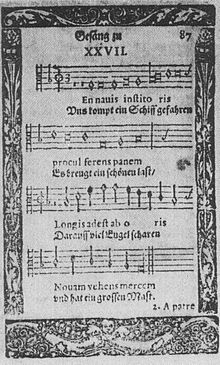"Es kommt ein Schiff, geladen" ("A ship is coming, laden"), is an Advent season chorale and Marian Hymn. It is one of the oldest religious songs of German origin.
| "Es kommt ein Schiff, geladen" | |
|---|---|
| Advent song | |
 "Uns kompt ein Schiff gefahren", Andernacher Gesangbuch, Cologne 1608, oldest evidence of the song | |
| Written | before 1450 |
| Text | Johannes Tauler? |
| Language | German |
| Published | 1608 |
History
editThe oldest existing text source is a manuscript dated before 1450. It was found in the Strasbourg Dominican convent of St. Nikolaus in undis. Due to the fact that the mystic Johannes Tauler visited this convent frequently, the lyrics of this song are attributed to him. Reference is the word "enphohet" (received) which is characteristically used by Tauler very often.[1]
The lyrics are typical for the allegory in the Middle Ages as a vital element in the synthesis of biblical and classical traditions. Biblical motifs compare the pregnant Virgin Mary with a loaded entering ship. The ship is set in motion under sail (correspondent to love) and mast (correspondent to the Holy Spirit).[2]
The oldest source of the melody is included in Andernacher Hymns (1608). The song is found there in bilingual text under the title "Vns kompt ein Schiff gefahren" as well as the Latin "En nauis institoris".
Lyrics
editEs kommt ein Schiff, geladen |
There comes a galley, laden |
Melody
edit- c.f. = cantus firmus
Musical setting
editMax Reger quotes the tune in his organ pieces Sieben Stücke, Op. 145.
See also
editReferences
edit- ^ Verse 5: "So wer das kint wilt kussen // for sinen roten munt // der enphohet groessen glusten // von im zu der selber stunt." Becker 2001, p. 62
- ^ Becker, Hansjakob (2001). Geistliches Wunderhorn: Große deutsche Kirchenlieder. C. H. Beck. pp. 60ff. ISBN 978-3-406-48094-2. Retrieved 14 September 2012.)
- ^ Lyrics according to: Evangelisches Gesangbuch, Ausgabe für die Evangelisch-Lutherischen Kirchen in Bayern und Thüringen. 2nd edition. Evangelischer Presseverband für Bayern, München 1995, ISBN 3-583-12100-7, p. 40.
- ^ Liederlexikon
- ^ The Cowley Carol Book For Christmas, Easter, and Ascensiontide, First Series, (George Ratcliffe Woodward, ed.), (London: A. R. Mowbray) 1901
- ^ G. A. Woodward, ed. (1922) [1902]. The Cowley Carol Book for Christmas, Easter and Ascension-tide (revised and enlarged ed.). London: A. R. Mowbray. p. 45.
External links
edit- "A ship is coming laden", English translation by Alan and Enid Luff
- Score
- Michael Fischer: Es kommt ein Schiff geladen. Ausführlicher Kommentar zur Liedgeschichte May 2005. (in German) (PDF, 1.11 MB)
- Es kommt ein Schiff, geladen, text in old German and Latin, by lyrik-und-lied.de
- "Es kommt ein Schiff, geladen" Carus-Verlag and SWR2 (in German)
- "Es kommt ein Schiff, geladen" music in lieder-archiv.de
- "Es kommt ein Schiff, geladen" on YouTube, arrangement by Max Reger, Cantamus Choir, Gießen
- Fantasia – Es kommt ein Schiff, geladen on YouTube, Fantasia for Organ by C. Meise, Bielefeld, Germany